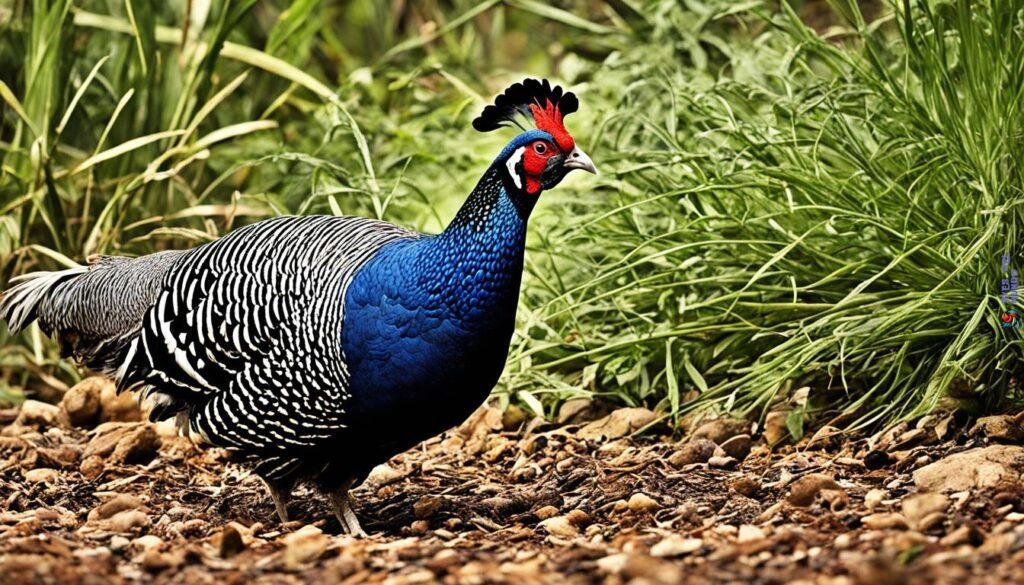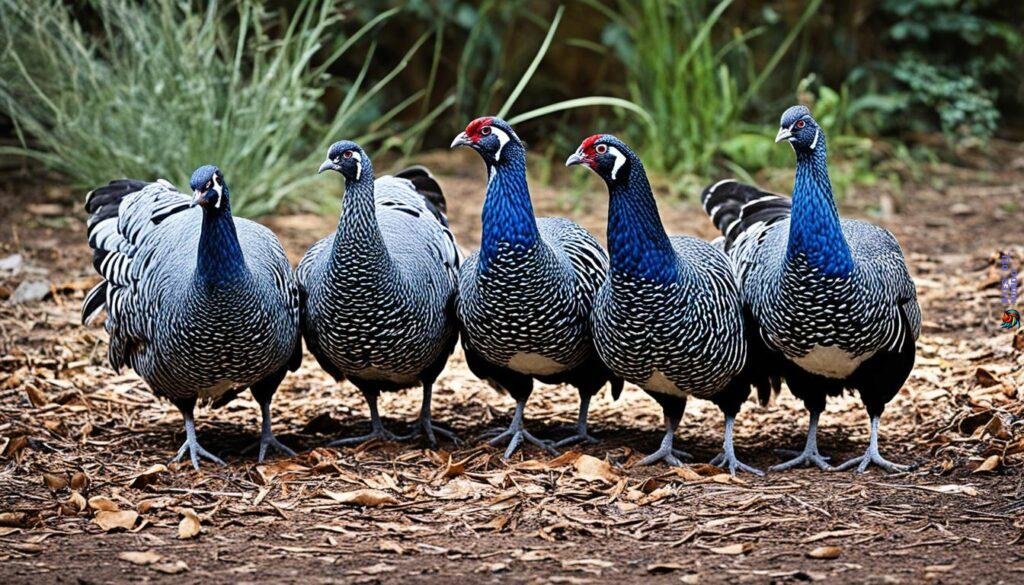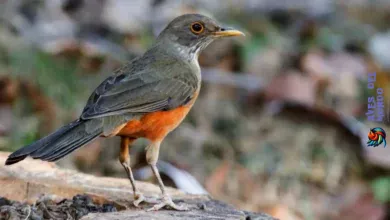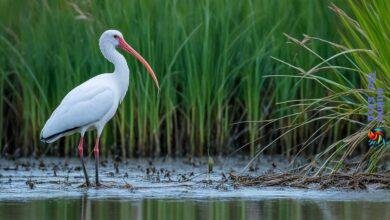Did you know guinea fowl show a complex social structure, much like mammals? This shows how avian social interactions are as intricate as those of higher mammals. It brings a sense of wonder to the social life of birds. Backyard bird watchers and researchers find the guinea fowl interactions especially fascinating.
Studying these birds, we see not just random acts but a complex set of social behaviors. Guinea fowl use vocal calls and various behaviors to establish their societal roles and keep the group united. This reveals how they achieve harmony and safety in their flocks.
So, diving into their world, we see their group life is not just about pecking and preening. It’s a story of community living, shaped by years of evolution. It’s an invitation to explore the amazing social dynamics of guinea fowls.
Understanding Guinea Fowl Social Dynamics
The world of guinea fowls is truly intriguing for those who love birds and manage flocks. It uncovers complicated and organized social behaviors. Knowing how guinea fowl interact and stand in their society helps in taking better care of them and appreciating their complex social world.

Formation and Stability of Guinea Fowl Groups
Group dynamics are key in guinea fowl society. These birds form stable, clear groups, seen in captivity and the wild. Cohesion within these groups starts young. Keets grow up in pens, which is vital until they can join the adult flock.
Inter-group Interactions and Hierarchies
Guinea fowl groups have a clear social order. This hierarchy keeps peace in the flock. Adult guinea fowls come back to the homestead for food when not foraging. This feeding ritual helps to understand the social order, from the leader to the followers.
| Age Group | Group Behavior | Hierarchy Interaction | Care Requirements |
|---|---|---|---|
| Keets (Juveniles) | Raised in pens, gradual introduction to the flock | Lower rank, observed from sidelines | Heat lamps, starter food, protection |
| Sub-Adults | Integration into larger groups, start to forage | Learning the social structure, establishing rank | Foraging experience, continued protection |
| Adults | Foraging, breeding, maintaining flock order | Defined roles, dominance established | Supplementary feeds, habitat maintenance |
In conclusion, guinea fowl’s social life is complex, with different stages displaying specific behaviors and care needs. Respecting the social hierarchy is crucial at all stages. For those raising guinea fowls, understanding and supporting these dynamics is key to a successful flock.
Communication Among Guinea Fowl
Getting to know how bird communication works shows us the depth of avian social interactions. In the bird world, the communication of guinea fowl is especially intriguing. They use special sounds to connect and share messages with each other.
Guinea fowl calls are loud and unique, very important in their lives. These sounds help them bond, mark their area, and warn each other of danger. Their calls show how complex bird life can be.
The sounds of male and female guinea fowl are different. Males have a single-tone call, while females use a two-tone sound. This clears up any confusion, helps in identifying each other, and plays a part in mating.
Males and females having different calls are important for their interactions and survival, not just random.
When guinea fowl sense danger, they use their calls to alert the flock. This shows how vital their sounds are for survival. It tells us a lot about their alertness and how they work together to stay safe.

Next time you see them, notice when and why they make different sounds. Each call has a purpose, showing their ability to work together. This highlights the amazing world of bird communication and their social connections.
Developing Bonds: Flock Integration in Guinea Fowl
Introducing young guinea fowls, also called keets, to their society is a sensitive process. It majorly affects flock relations. How we care for guinea fowl in these early days helps them learn to live in the group. The goal is more than just survival; it’s about forming connections that define their flock roles.

Nurturing Keets into the Flock
First, we lay the foundation, similar to building a house. We give keets the warmth they need and a non-slip surface to build strength. This early care, like nurturing a young plant, is crucial. Proper food and a good environment help keets grow and eventually join the adults.
Socializing Young Guinea Fowl with Adult Birds
In guinea fowl life, socializing is a slow, careful process. It respects their complex social world. By eight weeks, keets gradually meet the adults. This moment is crucial for their successful joining of the flock.
Watching closely and guiding gently is essential. It helps keets find their place and enrich the flock’s social fabric.
The Role of Habitat in Guinea Fowl Interactions
When raising guinea fowl, it’s key to grasp how guinea fowl housing affects bird behavior and bird community interactions. These lively birds need a well-planned habitat to fulfill their need to roam, roost, and forage. This ensures they exhibit healthy social behavior and flock harmony.
Guinea fowl thrive in environments close to their natural settings, with ample space for movement and foraging. Ideal habitats include grasslands and open fields bordered by shrubs or trees. These give them spots for retreat and roosting. To reduce stress and promote natural behaviors, protection against predators and harsh weather is crucial.

Your setup for guinea fowl housing should allow birds to be together but also have their privacy. The social structure of these birds is shaped by how resources are arranged. Here’s a table that outlines key habitat features beneficial for bird community interactions:
| Feature | Description | Benefit |
|---|---|---|
| Ample Space | Omnidirectional space for movement, foraging, and communal activities. | Supports flock dynamics and discourages territorial disputes. |
| Shelter and Protection | Structures that shield from predators and harsh weather while not confining the flock excessively. | Reduces stress and promotes natural resting behavior. |
| Natural Roosting Areas | Access to trees or elevated structures that align with their instinctual roosting preferences. | Encourages natural end-of-day gathering and lookout points. |
| Varied Terrain | Inclusion of different landscape elements such as bushes, grasses, and open areas. | Facilitates foraging and exploration, enhancing physical health and social interaction. |
| Food and Water Sources | Easily accessible and distributed feeding and watering stations to prevent crowding. | Ensures all birds get nourishment without competition leading to aggression. |
Choosing the right housing for guinea fowl influences the behaviors you’ll see. Open areas create healthy and sociable flocks. On the other hand, cramped spaces can lead to aggression and stress. By understanding how habitat affects guinea fowl, you can create a thriving community for these birds.
The Social Life of Birds: Comparing Guinea Fowl to Other Avians
When we look at bird society, guinea fowl and other birds show us amazing differences. The Vulturine Guineafowl, for example, has complex bird behavior and social skills that catch the eye of experts.

Birds interact in many ways. The Vulturine Guineafowl is special for its well-organized groups.
Avian Social Structures: Multi-level Societies in Birds
Not all birds are social, but the Vulturine Guineafowl live in complex societies. Their groups are structured and detailed, much like those of large mammals. This offers a fresh view on bird behavior.
Unique Behavior Traits of the Vulturine Guineafowl
The Vulturine Guineafowl is noteworthy in the bird society. They have unique traits in avian social interactions. They’re not big or great flyers, but their social system is quite developed. This suggests they might be smarter than we thought.
| Attribute | Guinea Fowl | Vulturine Guineafowl | Other Avian Species |
|---|---|---|---|
| Group Cohesion | Stable | Highly cohesive | Varies greatly |
| Social Structure | Simple hierarchy | Multi-level | Simple to complex |
| Communication | Vocal signals | Advanced vocalizations | Visual, vocal, and behavioral signals |
| Foraging Behavior | Collective | Requires space for natural foraging | Ranges from solitary to social foraging |
| Intelligence | Functional | Indicative of higher cognitive abilities | From instinctual to highly intelligent |
To sum it up, the Vulturine Guineafowl shows us the amazing diversity in bird society. Their advanced avian social interactions challenge what we thought about birds. They show us how adaptable and complex these creatures are.
Gender-Based Behavior in Guinea Fowl Societies
Guinea Fowl show different behaviors based on their gender, which is really interesting. These behaviors help us understand their social life better. Knowing these can help people who raise birds or love watching them.

Distinguishing Males from Females through Social Behaviors
In guinea fowl societies, it’s important to notice how males and females communicate differently. Males have a deep, consistent call. Females’ calls change in tone. These differences are crucial during mating season and help to know their status in the group.
Mating Dynamics and Hierarchies
Mating behaviors show how important gender is in their social structure. Males can get aggressive to show they are in charge and have a high rank for mating. If there are more males than females, this can lead to more fights. It might also make the flock pick mates in a way that doesn’t help with diversity.
| Behavior | Males | Females |
|---|---|---|
| Vocalizations | Single, consistent tone | Varying, two-toned call |
| Aggression | Exhibited, especially during mating season | Less apparent |
| Hierarchy in mating | Compete for top positions | Choose from available mates |
| Effect of sex ratio | Increased aggression and competition | Greater selective pressure in mate choice |
Understanding these bird behaviors makes us admire them more. It also helps bird keepers take better care of their flocks. Knowing about the mating and social behaviors is vital for these birds’ happiness and future.
Feeding Behavior and the Social Hierarchy of Guinea Fowl
Studying bird feeding behavior in guinea fowl reveals their social hierarchy and flock dynamics. You can see complex patterns in how they interact, especially when they eat and look for food.

Foraging as a Group: Predator Avoidance and Food Sharing
For guinea fowl, foraging is about getting food and surviving together. They use their group’s alertness to stay safe from predators. While watching them, you’ll see sharing food is key in their groups, showing they value the group’s well-being.
Supplemental Feeding and Its Impact on Social Interactions
Supplemental feeding changes guinea fowl’s normal behavior and social rankings. This help from humans ensures they get enough to eat. But, it can also change their natural ways of finding food and affect their social structure.
| Behavior | Impact on Social Hierarchy | Notes |
|---|---|---|
| Group Foraging | Enhanced predator awareness, equitable food access | Contributes to the balance and cohesion within the flock |
| Supplemental Feeding | Can create dependence, alter natural behaviors | Requires careful management to avoid dominance conflicts |
| Resource Distribution | Reflects and sustains existing pecking order | Important for maintaining order and minimizing altercations |
Looking closely at guinea fowl’s feeding behavior shows how their society is organized. Noticing these behaviors helps us understand bird community interactions. It shows the balance between survival, food, and social structure in birds’ lives.
Predation, Vigilance and the Group Cohesion of Guinea Fowl
Exploring the social behaviors of birds reveals the guinea fowl’s unique bond. Their survival relies on group cohesion, particularly against predators. Unlike other birds that flee individually, guinea fowl unite, showcasing strong social ties. This unity is revealed through their loud calls. These sounds are alarm signals, warning the flock of danger nearby.
Guinea fowl’s behavior is a response to their environment. Witnessing their collective vigilance is extraordinary. If one bird senses a threat, the rest quickly follow suit. This shows remarkable unity and quick reaction. Their survival depends on being aware of their surroundings. By acting together, they’ve adapted to live in many places.
Guinea fowl life is about more than just flock structure; it’s about collective survival. They rely on each other for safety, making them confident while foraging. Each bird plays a key role in their group defense. Studying their behavior offers insight into how birds deal with predators and adapt over time.



